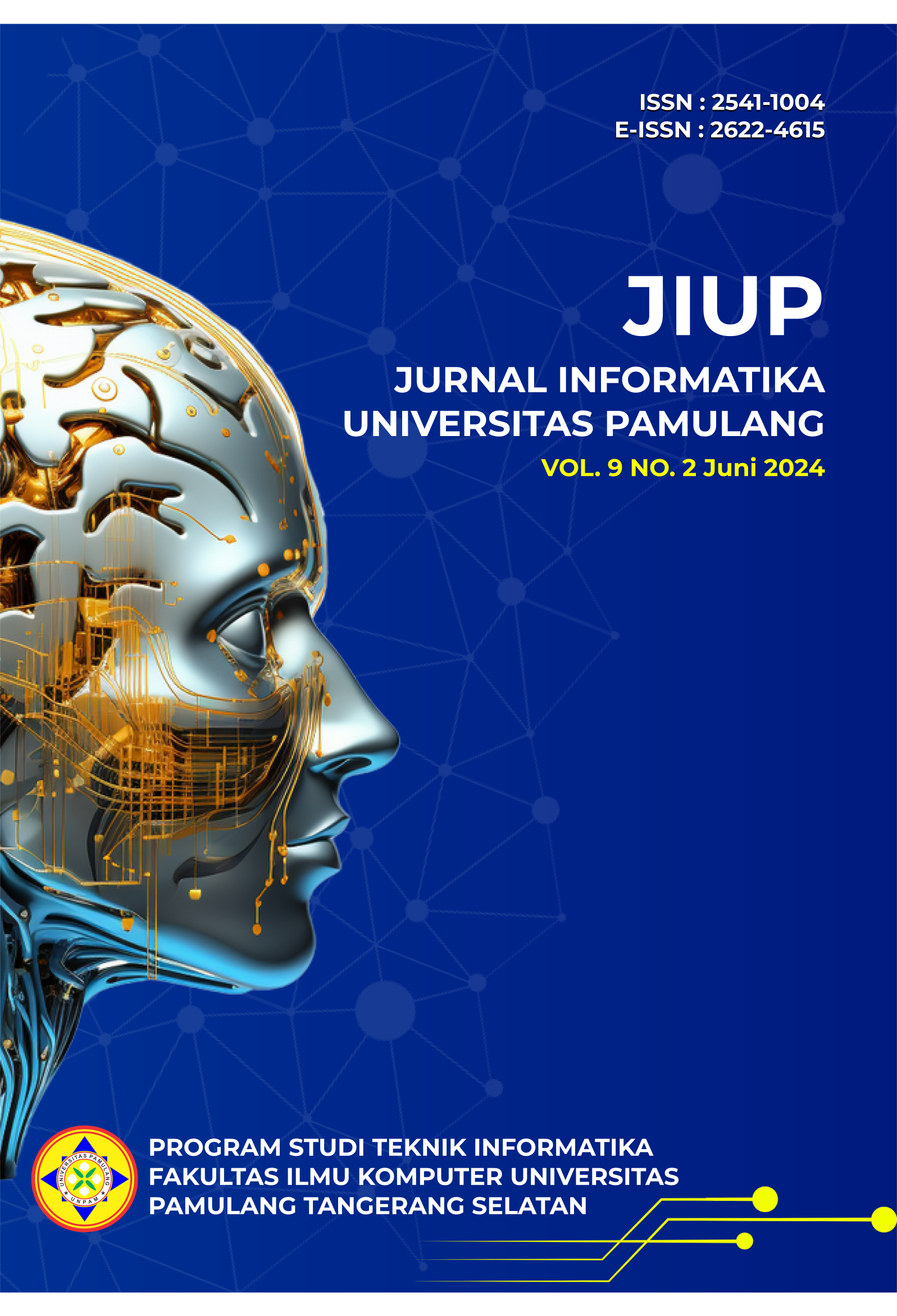Implementasi Teks Mining Pada Website Kemenkes Dengan Metode LDA Menggunakan Algoritma K-Means
DOI:
https://doi.org/10.32493/informatika.v9i2.38971Keywords:
Text Mining, Topic Modeling, LDA Model, K-MeansAbstract
This research aims to improving the accessibility and management of health information on the Ministry of Health (Kemenkes) website. Before this research was conducted, content on the Ministry of Health's website was scattered without a clear structure, making it difficult for users to find the health information they needed quickly and efficiently. This results in a decrease in the quality of the user experience and a potential decrease in trust in official health information sources. With the aim of making it easier for users to find relevant information, this research uses the K-Means algorithm to group website content based on themes. Through the text mining method, five main clusters were identified, covering topics such as emergency health, certain diseases, and innovations in handling COVID-19. The results show an increase in navigation efficiency with clustering accuracy reaching 72%. The conclusion of this research is that this grouping succeeded in improving the structure and quality of information on the Ministry of Health's website, supporting data-based decision making, and improving public health services.
References
Alfanzar, Alif Iffan, and Indri Sudanawati Rozas. 2020. “Topic Modelling Skripsi Menggunakan Metode Latent.” JSiI (Jurnal Sistem Informasi) 7(1): 7–13.
Anjar, Agus, Muhammad Khairul Ritonga, and Toni Toni. 2021. “DAMPAK POSITIF DAN NEGATIF PERKEMBANGAN TEKNOLOGI KOMUNIKASI TERHADAP MAHASISWA PPKn FKIP LABUHANBATU.” Civitas (Jurnal Pembelajaran Dan Ilmu Civic) 7(2): 41–44.
Azizah, Anestasya Nur, Tatik Widiharih, and Arief Rachman Hakim. 2022. “Kernel K-Means Clustering Untuk Pengelompokan Sungai Di Kota Semarang Berdasarkan Faktor Pencemaran Air.” Jurnal Gaussian 11(2): 228–36.
Bangkalang, Dwi Hosanna. 2023. “Analisis Dan Penerapan Topic Modeling Pada Judul Tugas Akhir Mahasiswa Menggunakan Metode Latent Dirichlet Allocation (Lda).” 8(4): 1275–87.
Bryan Orleans, Edi Purnomo Putra. 2022. “Clustering Algoritma (K-Means).” Binus. https://sis.binus.ac.id/2022/01/31/clustering-algoritma-k-means/.
Cahyono, Nuri, and Angga Reni Dwi Astuti. 2023. “Analisis Topic Modelling Persepsi Pengguna Internet Menggunakan Metode Latent Dirichlet Allocation.” Indonesian Journal of Computer Science 12(1): 326–34.
Deolika, Agatha, Kusrini Kusrini, and Emha Taufiq Luthfi. 2019. “Analisis Pembobotan Kata Pada Klasifikasi Text Mining.” Jurnal Teknologi Informasi 3(2): 179.
Dinda Adimanggala, Fitra Abdurrachman Bachtiar, and Eko Setiawan. 2021. “Evaluasi Topik Tersembunyi Berdasarkan Aspect Extraction Menggunakan Pengembangan Latent Dirichlet Allocation.” Jurnal RESTI (Rekayasa Sistem dan Teknologi Informasi) 5(3): 511–19.
Doni. 2022. “Literasi Digital Masyarakat Indonesia Membaik.” kominfo. https://www.kominfo.go.id/content/detail/39858/literasi-digital-masyarakat-indonesia-membaik/0/artikel.
Ekasetya, Vada Annisa, and Arief Jananto. 2020. “Klusterisasi Optimal Dengan Elbow Method Untuk Pengelompokan Data Kecelakaan Lalu Lintas Di Kota Semarang.” Jurnal Dinamika Informatika 12(1): 20–28.
Galuh Nurvinda K. 2022. “Algoritma Clustering Data Science Terupdate 2022.” DQLab. https://dqlab.id/algoritma-clustering-data-science-terupdate-2022.
Indrayuni, Elly. 2019. “Klasifikasi Text Mining Review Produk Kosmetik Untuk Teks Bahasa Indonesia Menggunakan Algoritma Naive Bayes.” Jurnal Khatulistiwa Informatika 7(1): 29–36.
Nurlayli, Akhsin, and Moch. Ari Nasichuddin. 2019. “Topik Modeling Penelitian Dosen Jptei Uny Pada Google Scholar Menggunakan Latent Dirichlet Allocation.” Elinvo (Electronics, Informatics, and Vocational Education) 4(2): 154–61.
Paembonan, Solmin, and Hisma Abduh. 2021. “Penerapan Metode Silhouette Coefficient Untuk Evaluasi Clustering Obat.” PENA TEKNIK: Jurnal Ilmiah Ilmu-Ilmu Teknik 6(2): 48.
Patmawati, Patmawati, and Muhammad Yusuf. 2021. “Analisis Topik Modelling Terhadap Penggunaan Sosial Media Twitter Oleh Pejabat Negara.” Building of Informatics, Technology and Science (BITS) 3(3): 122–29.
Rusdhi, Vira Faradhiba, and Ilmiyati Sari. 2022. “Identifikasi Topik Artikel Berita Menggunakan Topic Modelling Dengan Latent Dirichlet Allocation.” Jurnal Ilmiah Informatika Komputer 27(2): 169–76.
Santoso, Kevin Rafi Adjie Putra, Asmaul Husna, Nadia Widyawati Putri, and Nur Aini Rakhmawati. 2022. “Analisis Topik Tagar Covidindonesia Pada Instagram Menggunakan Latent Dirichlet Allocation.” JISKA (Jurnal Informatika Sunan Kalijaga) 7(1): 1–9.
Tineges, Rian. 2021. “Tahapan Text Preprocessing Dalam Teknik Pengolahan Data.” DQLab. https://dqlab.id/tahapan-text-preprocessing-dalam-teknik-pengolahan-data.
Wahyudin. 2020. “Aplikasi Topic Modeling Pada Pemberitaan.” Seminar Nasional Official Statistic: Pengembangan Official Statistics dalam mendukung Implementasi SDG’s: 309–18.
Woro, Verianty Anjar. 2022. “Yang Dimaksud Dengan Berita Adalah Informasi Peristiwa, Kenali Unsur Dan Faktornya.” Lioutan6.com. https://www.liputan6.com/hot/read/5142500/yang-dimaksud-dengan-berita-adalah-informasi-peristiwa-kenali-unsur-dan-faktornya?page=4 (December 21, 2023).
Downloads
Published
Issue
Section
License
Copyright (c) 2024 Ari Setiawan, Deden Wahiddin, Cici Emilia Sukmawati

This work is licensed under a Creative Commons Attribution-NonCommercial 4.0 International License.
Authors who publish with this journal agree to the following terms:
- Authors retain copyright and grant the journal right of first publication with the work simultaneously licensed under a Creative Commons Attribution-NonCommercial 4.0 International (CC BY-NC 4.0) that allows others to share the work with an acknowledgement of the work's authorship and initial publication in this journal.
- Authors are able to enter into separate, additional contractual arrangements for the non-exclusive distribution of the journal's published version of the work (e.g., post it to an institutional repository or publish it in a book), with an acknowledgement of its initial publication in this journal.
- Authors are permitted and encouraged to post their work online (e.g., in institutional repositories or on their website) prior to and during the submission process, as it can lead to productive exchanges, as well as earlier and greater citation of published work (See The Effect of Open Access).
Jurnal Informatika Universitas Pamulang have CC-BY-NC or an equivalent license as the optimal license for the publication, distribution, use, and reuse of scholarly work.
In developing strategy and setting priorities, Jurnal Informatika Universitas Pamulang recognize that free access is better than priced access, libre access is better than free access, and libre under CC-BY-NC or the equivalent is better than libre under more restrictive open licenses. We should achieve what we can when we can. We should not delay achieving free in order to achieve libre, and we should not stop with free when we can achieve libre.
Jurnal Informatika Universitas Pamulang is licensed under a Creative Commons Attribution-NonCommercial 4.0 International (CC BY-NC 4.0)
YOU ARE FREE TO:
- Share : copy and redistribute the material in any medium or format
- Adapt : remix, transform, and build upon the material for any purpose, even commercially.
- The licensor cannot revoke these freedoms as long as you follow the license terms





